Were you looking for stunningly beautiful orange birds? If so, you’re exactly where you need to be, as we’ve found 13 of the most distinctive birds with orange plumage! Some of them are pretty rare, so they’re definitely worth considering if you’re a birdwatcher!
13 Orange Bird Species
Keep reading to learn about 13 orange bird species – the last two are undoubtedly exotic!
1. Altamira Oriole
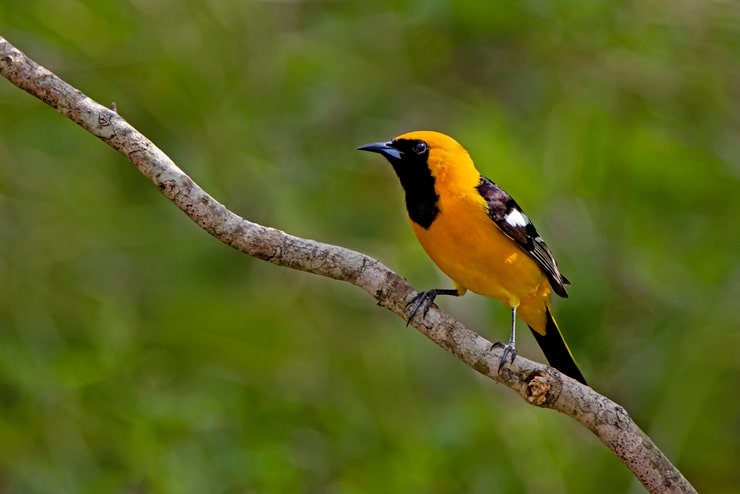
- Scientific name: Icterus gularis
- Size: 8.3 – 9.8 inches
- Weight: 1.7 – 2.3 ounces
- Wingspan: 14.2 inches
Altamira oriole birds have an incredible orange-black-white coloration! They live in northern Central America and the Mexican Gulf coast, as well as on the Pacific coast, where they are year-round residents. In 1939, these birds reached southern Texas, too, and have been living there ever since.
Altamira orioles are abundant in semi-arid areas or open riparian woodlands, where they look for food in high trees or shrubs, primarily feeding on berries and insects.
They’re a solitary species and usually build their nests far from other birds’ nests. Females are primarily responsible for building the nest. Their breeding season starts in April and continues through late July. While the nest is the females’ responsibility, both males and females care for their young.
These orange birds have a unique call, which sounds like a clipped “ike.” However, this sound is usually used only as a contact call. They may also be heard emitting harsh chattering calls, as well as two-note whistles.
2. Spot-Breasted Oriole
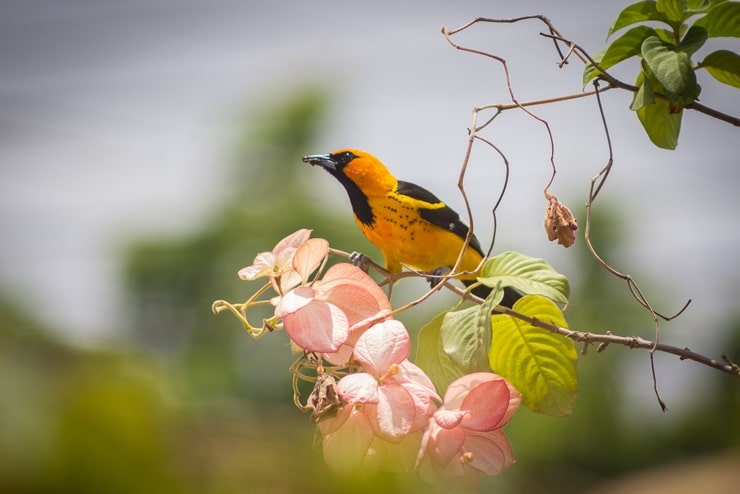
- Scientific name: Icterus pectoralis
- Size: 8.3 – 9.4 inches
- Weight: 1.6 – 1.8 ounces
The spot-breasted oriole is native to Central America and is found in El Salvador, Costa Rica, Honduras, Guatemala, Nicaragua, and Mexico. However, a breeding population was introduced to southern Florida, as well. They are considered year-long residents. However, as resistant as they are, their population numbers dropped during the cold winters in the late 1970s.
These orange birds typically inhabit subtropical or tropical dry forests. Nevertheless, they can also be spotted in subtropical and tropical moist lowland forests. In their natural habitat, spot-breasted orioles feed on nectar, berries, and insects, although some may also eat the flowers altogether with the nectar.
Their nests are usually built on trees, usually well above the ground, although some birds were spotted building their nests on low plants like yuccas.
Females are believed to build the nests, which consist of palm fibers, grass, and other plants that form a hanging pouch.
3. Rufous Hummingbird
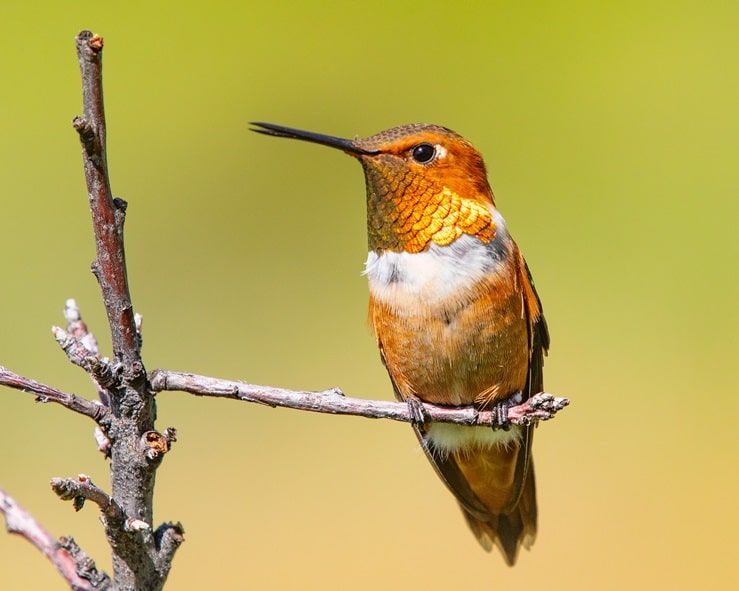
- Scientific name: Selasphorus rufus
- Size: 2.8 – 3.5 inches
- Weight: 0.071 – 0.176 ounces
- Wingspan: 4.3 inches
The Selasphorus rufus, or, as it’s commonly called, rufous hummingbird, is native to North America. Their breeding range extends on the western part of the continent, from the center to the north, inhabiting forest edges and clearings. During the winter, though, they travel south to Guerrero, a Mexican state, where they live in pine-oak woods.
Rufous hummingbirds are nectar-feeding birds, preferring scarlet sage, paintbrush, and gilia, among others. However, they may sometimes eat insects, too.
The nests are built in protected areas, typically on conifers or shrubs. They are usually located 3 – 30 feet above the ground and consist of grass, spider webs, moss, and other soft materials, which give them the form of a compact cup.
The young birds are fed by the females, which stick their bills into their babies’ mouths and regurgitate tiny insects for them.
4. Bullock’s Oriole
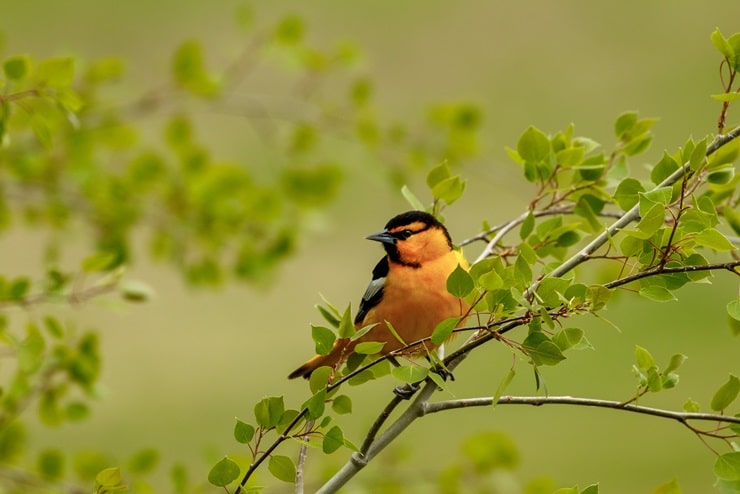
- Scientific name: Icterus bullockii
- Size: 6.7 – 7.5 inches
- Weight: 1 – 1.5 ounces
- Wingspan: 12.2 inches
Bullock’s orioles are native to the North American continent, inhabiting open woods and riverside groves. The birds are migratory, and their breeding grounds extend from the border between the U.S. and Canada south to Texas, while the winter grounds are typically in Mexico.
Bullock’s orioles prefer inhabiting open deciduous woodlands and forest edges and are often found near cottonwood, willow, and pecan trees.
These small birds feed on berries, insects, and nectar. Favorite insects include caterpillars, crickets, grasshoppers, and wasps.
Their breeding season usually starts in May and lasts until July, although this highly depends on where the birds breed. Males and females build their nests together, which are deep, pendant baskets. They consist of bark and fine grass fiber and are lined with hair and moss. Females usually lay 4 – 5 eggs, and the nestlings are subsequently fed and cared for by both parents.
5. Northern Red Bishop
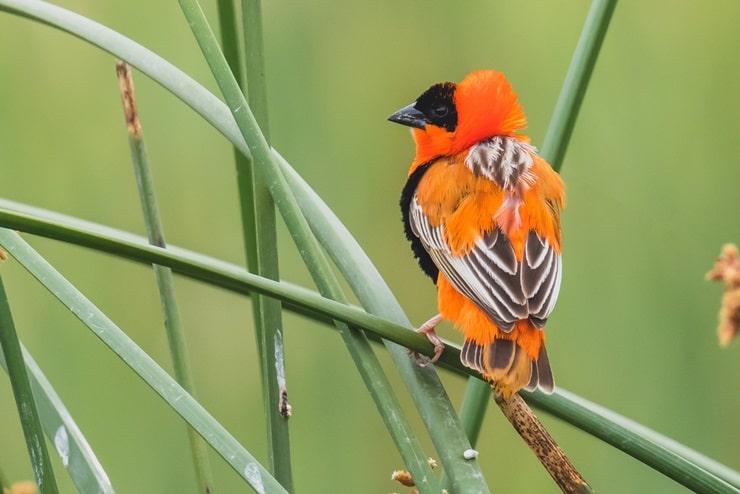
- Scientific name: Euplectes fanciscanus
- Size: 4.3 inches
- Weight: 0.4 – 0.7 ounces
Although called Northern red bishop, this bird usually has a bright orange, almost red plumage. Unlike other birds on our list, this species is natively found across northern Africa. However, some populations were introduced to Puerto Rico, California, Hawaii, and Texas, while other individuals were spotted in Cuba, Martinique, Barbados, and other regions. They are believed to be non-migratory birds.
Northern red bishops prefer inhabiting brushy thickets, marsh or pond edges, and overgrown fields. They usually eat seeds but may sometimes feed on insects.
Interestingly, their specific black-orange-reddish coloration has the purpose of attracting mates. Unlike the typical behavior of other birds on our list, northern red bishop nests are built by male birds and consist of grasses and reeds that form a spherical nest.
6. Flame-Colored Tanager
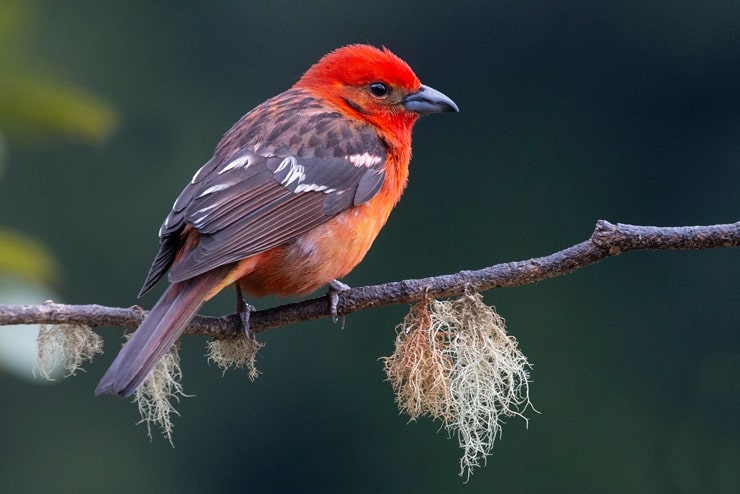
- Scientific name: Piranga bidentata
- Size: 7.1 – 7.5 inches
- Weight: 1.13 – 1.71 ounces
- Wingspan: 12.2 inches
The flame-colored tanager is also called stripe-backed tanager. This gorgeous red-orange bird is native to Central America, ranging from Mexico to Panama. However, some individuals were spotted in the United States, too. They prefer living in the canopy of humid mountainous forests. Nevertheless, some populations are found in non-forested areas, too. Most often, these include gardens, pastures, and coffee plantations.
These medium-sized birds feed on small arthropods and berries, occasionally on ants and wasps. Their breeding season is April – May, when they build open-cup nests of coarse material.
The bird can be distinguished from other species by its beautiful call, which sounds like a “chi-dick.”
7. Black-Headed Grosbeak

- Scientific name: Pheucticus melanocephalus
- Size: 7.1 – 7.5 inches
- Weight: 1.2 – 1.7 ounces
- Wingspan: 12.6 inches
The Pheucticus melanocephalus, or the black-headed grosbeak, is another orange bird on our list, although its plumage isn’t as bright as that of other species.
These birds are native to the North American continent. They’re year-round residents in Mexico, while their breeding grounds extend from the border between the U.S. and Canada south to Texas. The migratory populations spend their winters in Mexico.
These birds naturally live in deciduous and mixed forests, breeding in pine-oak woodlands or streamside groves of willow and cottonwood. During migration, black-headed grosbeaks can be spotted in open woods, desert washers, and streamside trees, while their wintering grounds include tropical open woods and brushes.
Black-headed grosbeaks prefer eating seeds, insects, spiders, berries, and fruit. Favorite insects include beetles, wasps, bees, and flies. Sometimes they feed on snails, too.
During the breeding season, the nests are primarily built by females. They are open-cup nests consisting of twigs, pine needles, rootlets, and wigs, lined with animal hair or plant fibers. The incubation is done by both parents, although only females incubate at night. The young learn how to fly once they’re at least two weeks old.
8. Blackburnian Warbler

- Scientific name: Setophaga fusca
- Size: 4.3 – 5.1 inches
- Weight: 0.28 – 0.46 ounces
- Wingspan: 7.9 – 8.7 inches
Blackburnian warblers live in eastern North America, southern Central America, and northwestern South America. During the breeding season, the birds are located in North America, flying south to Central and South America for the winter. In the north, they live in boreal coniferous and mixed forests or fully deciduous forests. During the winter, Blackburnian warblers are found in humid mountain forests.
These orange birds primarily feed on insects, caterpillars being their favorite. However, if caterpillars aren’t abundant, they’ll eat ants, beetles, flies, and spiders. Male birds typically forage higher than females.
The breeding season is thought to start in May, with males reaching the breeding grounds before females. The nests are usually built in dense vegetation, typically up to 80 feet above the ground. Like the nests of other birds on our list, the nests of Blackburnian warblers are cup-shaped and built of twigs, fibers, and bark. It’s most often lined with grass, hair, or conifer needles.
9. Baltimore Oriole
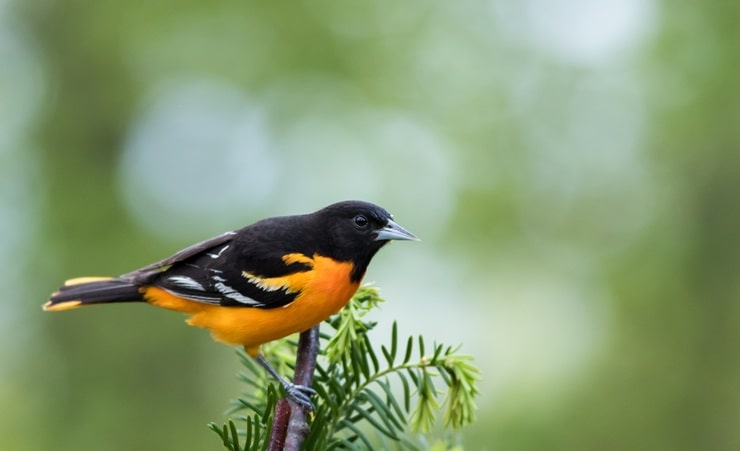
- Scientific name: Icterus galbula
- Size: 6.7 – 8.7 inches
- Weight: 0.79 – 1.48 ounces
- Wingspan: 9.1 – 12.6 inches
The Baltimore oriole is a migratory bird native to North America. It breeds in the central and eastern parts of the continent, while the wintering grounds extend from Mexico to northern South America. These orioles breed in deciduous or mixed woodlands and winter in forest edges found in the tropics.
They feed on nectar, berries, and insects. However, they sometimes eat spiders and snails, too. This oriole species usually forages in shrubs and trees but sometimes catches insects in mid-flight.
The breeding season starts in the spring when the males establish a territory and “attract” females by chattering and singing in front of them. The females build the nest, which is a bindle-like pouch. It’s typically built at the end of a branch on an elm, maple, cottonwood, willow, or apple tree. The females use anything they can find to secure the nest.
Male Baltimore orioles produce loud flutey whistles, usually heard from the tree canopy.
11. American Redstart
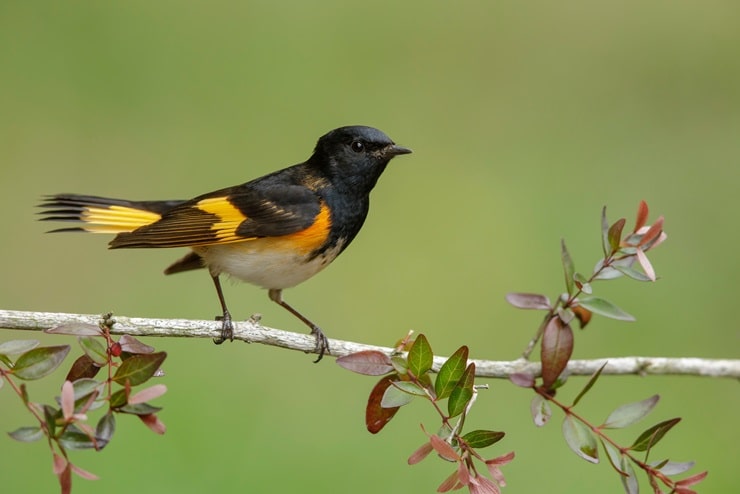
- Scientific name: Setophaga ruticilla
- Size: 4.3 – 5.5 inches
- Weight: 0.25 – 0.3 ounces
- Wingspan: 6.4 – 9.1 inches
While the American redstart isn’t predominantly orange, its bright orange-black-white coloration makes it unique!
These birds are native to North and South America. They are migratory, breeding in North America throughout Canada and the eastern United States and wintering in Central America, northern South America, and the West Indies. Rarely, American redstarts migrate as far as western Europe.
These birds prefer living in deciduous forests and forest edges during the breeding season. On the other hand, wintering grounds include all types of woody ecosystems.
American redstarts are insectivorous and often catch insects in mid-flight. They usually eat caterpillars, flies, leafhoppers, beetles, aphids, and spiders. Sometimes these birds resort to feeding on berries if other food sources are scarce.
Their breeding season starts with a distinctive mating strategy when the male displays courtship by raising crown feathers, fluffing plumage, and spreading the wings and the tail. The females pick the nest site, which is never built on the ground. The nest is an open cup consisting of rootlets, grass, and plant fibers.
12. Allen’s Hummingbird

- Scientific name: Selasphorus sasin
- Size: 3 – 3.5 inches
- Weight: 0.1 ounces
- Wingspan: 4.3 inches
Allen’s hummingbirds have a distinctive appearance thanks to their orange-red colors mixed with olive brown.
These birds are endemic to North America, where they inhabit open oak woods, well-wooded suburbs, streamside groves, and city parks – that is, during the breeding season. However, since they’re migratory and fly to the south when the temperatures drop, Allen’s hummingbirds overwinter in Mexico’s foothills and mountain forests.
They feed on insects and flowers like penstemon, red columbine, scarlet sage, and paintbrush. The start of their breeding season highly depends on geographical factors. What’s certain, though, is that males have a J-shaped courtship display pattern.
They fly high, dive steeply with a whine when they get to the bottom, then curve up at a moderate height. Females build their nests on trees or shrubs, usually close to the ground. The nests consist of plant fibers, spider webs, and lichen. As the young grow, the females enlarge the nest.
13. Guianan Cock-of-the-Rock
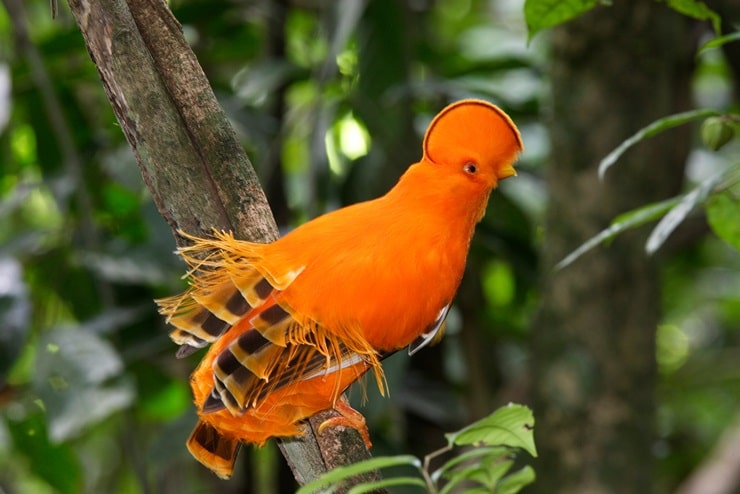
- Scientific name: Rupicola rupicola
- Size: 12 inches
- Weight: 7.1 – 7.8 ounces
This is by far the most beautiful and distinctive orange bird on our list, thanks to the males’ bright orange plumage, crest, and ornamental feathers! The Guianan cock-of-the-rock is endemic to South America, where it inhabits tropical rainforests. These birds aren’t migratory.
They are frugivores, primarily eating fruits, although they sometimes prey on insects, small snakes, and lizards.
Breeding occurs during the first months of the year, as females usually lay their eggs in March. Males display a unique courting behavior called “lek.”
Unlike other birds on our list, the nests of Guianan cock-of-the-rock are built on rocky cliff faces or caves. They’re solid moldings consisting of plant material and mud.
13. Orange Fruit Dove
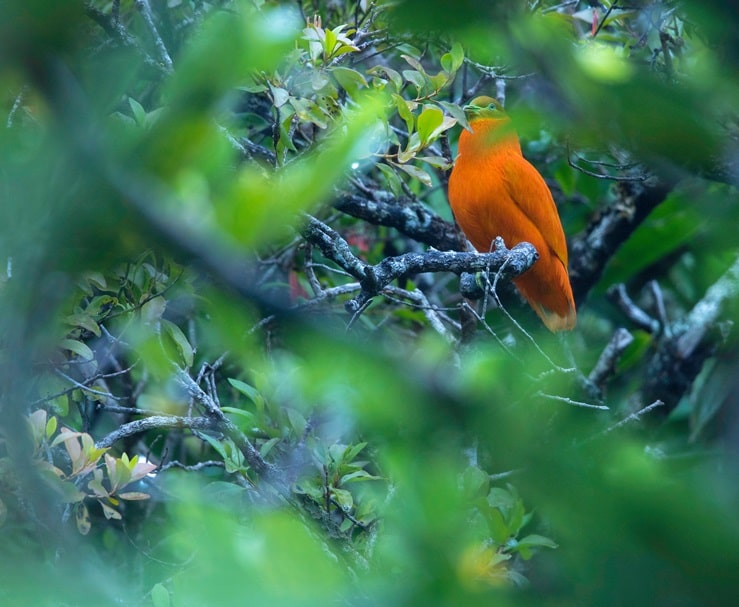
- Scientific name: Ptilinopus victor
- Size: 8 inches
These birds are very rare, as they’re endemic to Fiji, inhabiting woodlands at elevations between 1,380 and 3,220 feet.
Orange fruit doves primarily eat small fruits and berries, although they sometimes feed on the caterpillars found on leaves. The breeding season is extended, as orange fruit doves were observed nesting in summer, fall, and winter.
The nests are built low on trees and consist of intertwined sticks. Females lay a maximum of two eggs and subsequently take care of them alone.
Discover Other Colored Birds:
Red Birds
Pink Birds
Purple Birds
Brown Birds
White Birds
